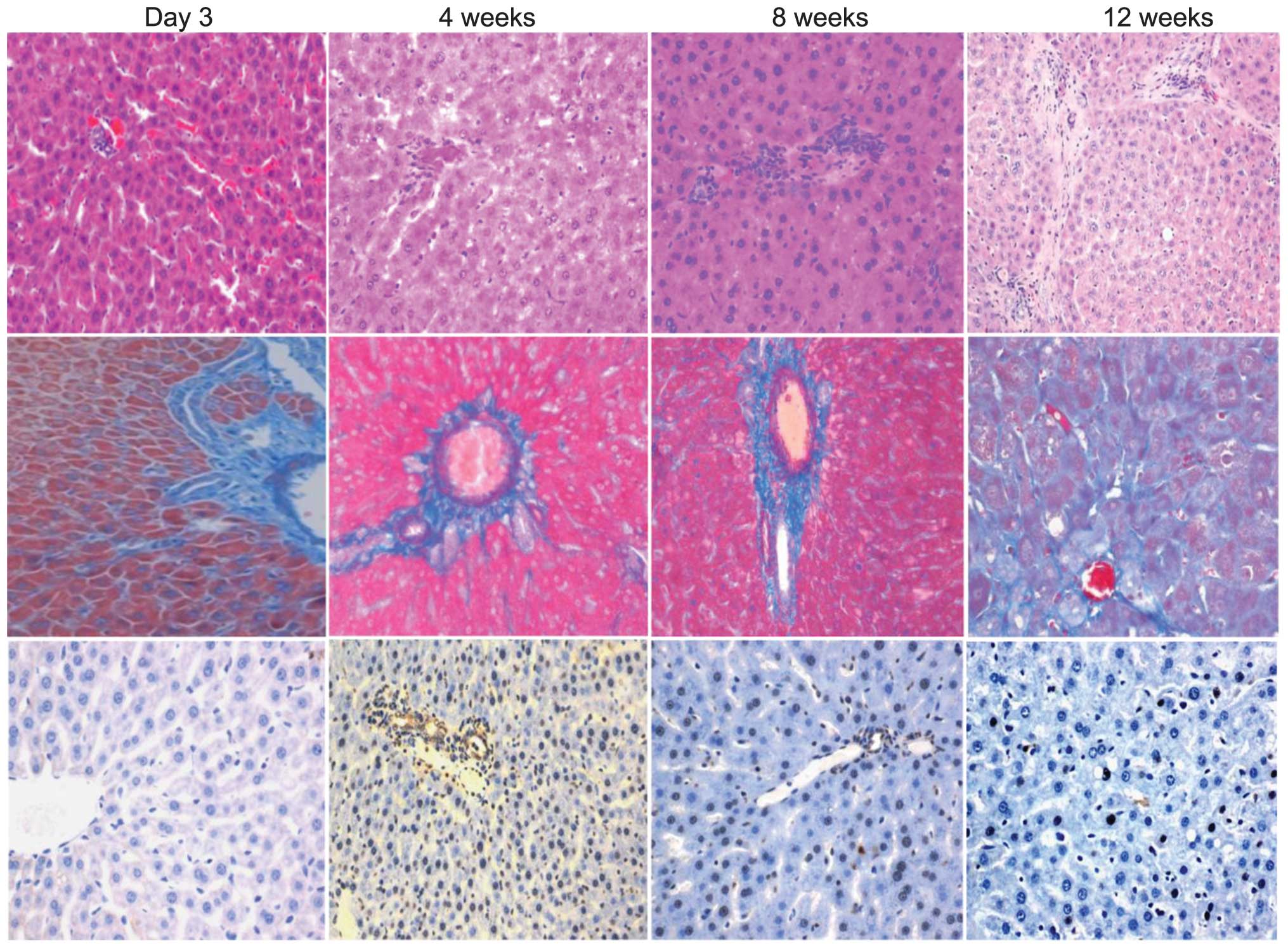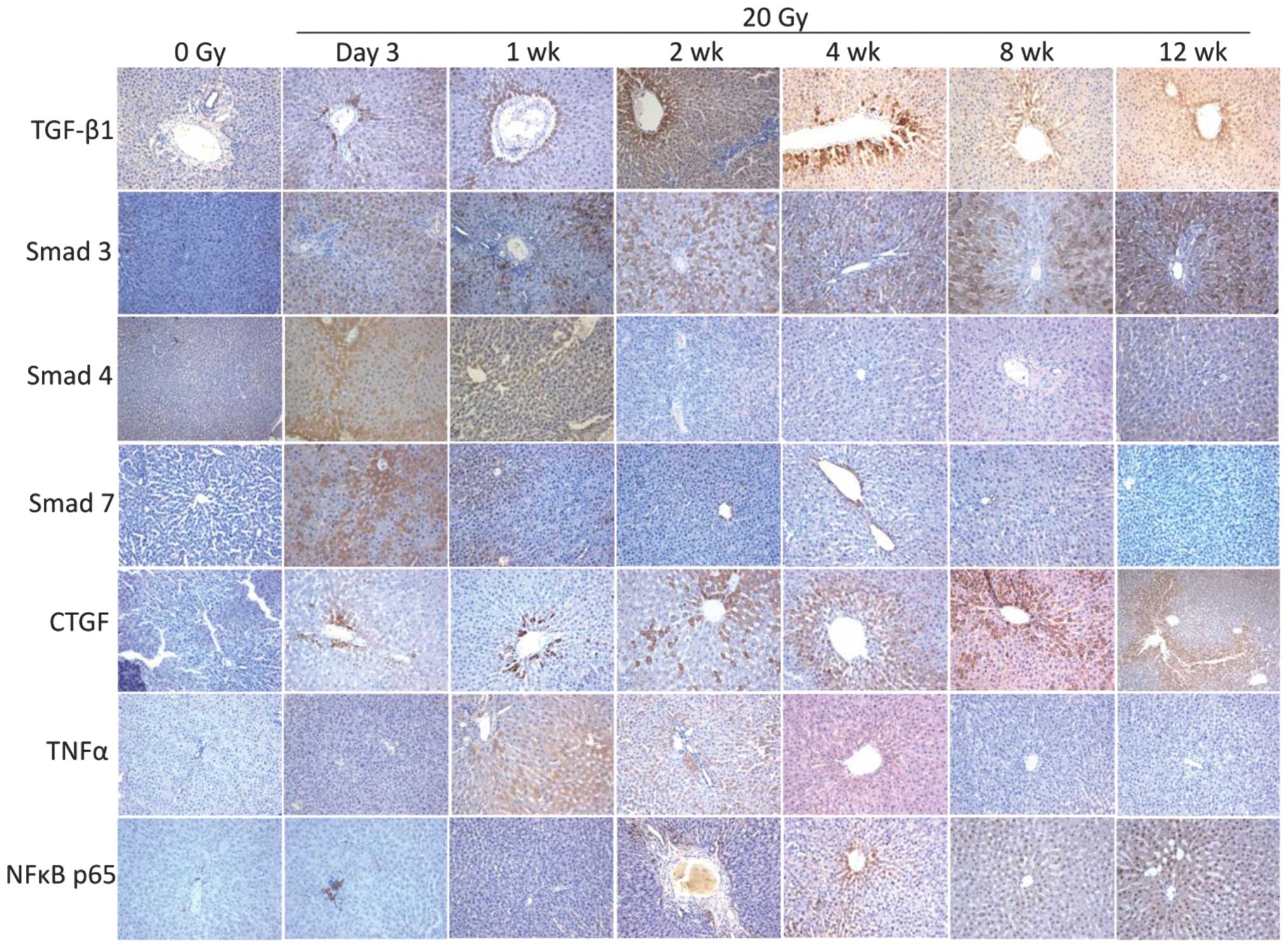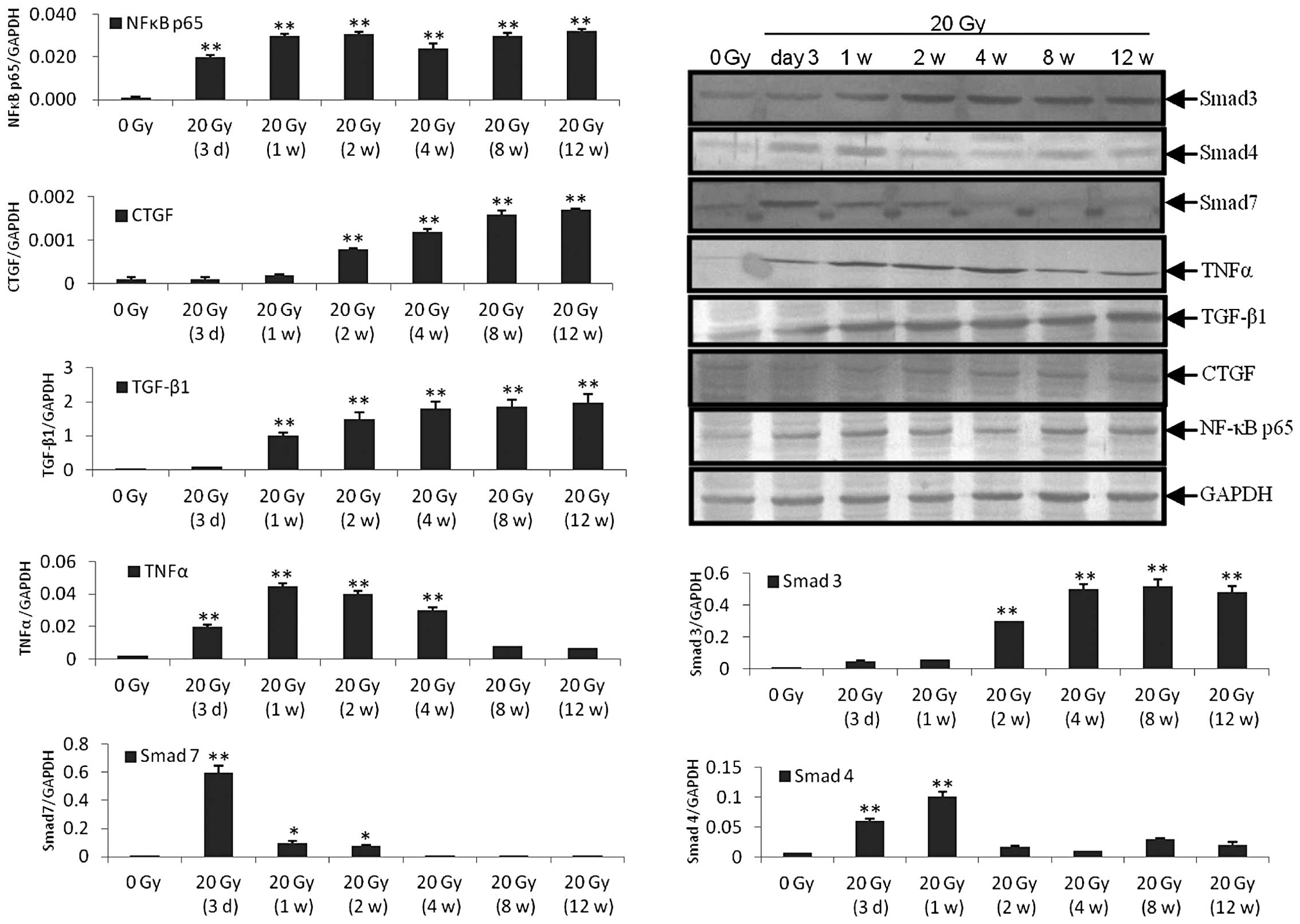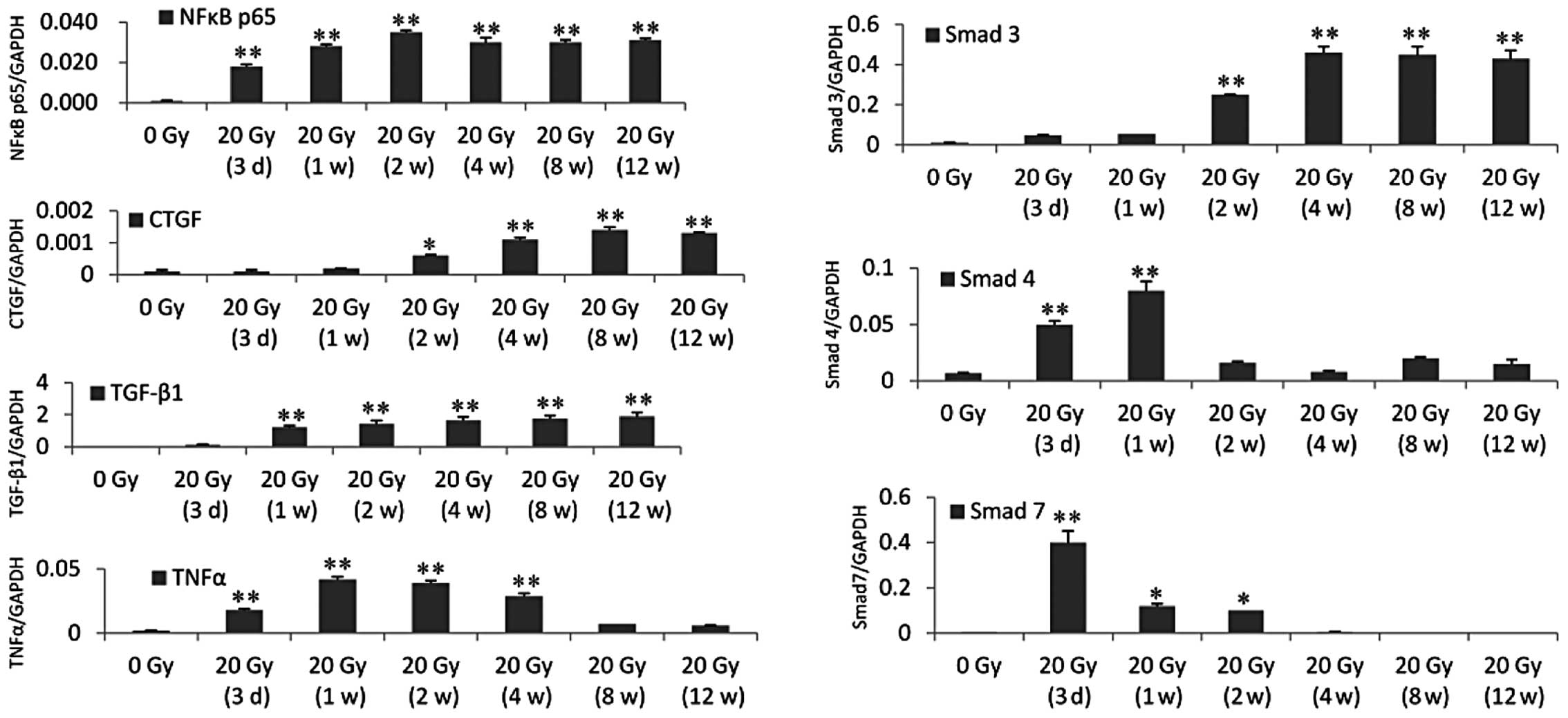|
1
|
Liang SX, Zhu XD, Xu ZY, Zhu J, Zhao JD,
Lu HJ, et al: Radiation-induced liver disease in three-dimensional
conformal radiation therapy for primary liver carcinoma: The risk
factors and hepatic radiation tolerance. Int J Radiat Oncol Biol
Phys. 65:426–434. 2006. View Article : Google Scholar : PubMed/NCBI
|
|
2
|
Gil-Alzugaray B, Chopitea A, Iñarrairaegui
M, Bilbao JI, Rodriguez-Fraile M, Rodriguez J, et al: Prognostic
factors and prevention of radioembolization-induced liver disease.
Hepatology. 57:1078–1087. 2013. View Article : Google Scholar
|
|
3
|
Guha C and Kavanagh BD: Hepatic radiation
toxicity: Avoidance and amelioration. Semin Radiat Oncol.
21:256–263. 2011. View Article : Google Scholar : PubMed/NCBI
|
|
4
|
Shi SR, Key ME and Kalra KL: Antigen
retrieval in formalin-fixed, paraffin-embedded tissues: an
enhancement method for immunohistochemical staining based on
microwave oven heating of tissue sections. J Histochem Cytochem.
39:741–748. 1991. View Article : Google Scholar : PubMed/NCBI
|
|
5
|
Schmittgen TD and Livak KJ: Analyzing
real-time PCR data by the comparative C(T) method. Nat Protoc.
3:1101–1108. 2008. View Article : Google Scholar : PubMed/NCBI
|
|
6
|
Xu ZY, Liang SX, Zhu J, Zhu XD, Zhao JD,
Lu HJ, et al: Prediction of radiation-induced liver disease by
Lyman normal-tissue complication probability model in
three-dimensional conformal radiation therapy for primary liver
carcinoma. Int J Radiat Oncol Biol Phys. 65:189–195. 2006.
View Article : Google Scholar : PubMed/NCBI
|
|
7
|
Cheng JC, Wu JK, Huang CM, Liu HS, Huang
DY, Cheng SH, et al: Radiation-induced liver disease after
three-dimensional conformal radiotherapy for patients with
hepatocellular carcinoma: Dosimetric analysis and implication. Int
J Radiat Oncol Biol Phys. 54:156–162. 2002. View Article : Google Scholar : PubMed/NCBI
|
|
8
|
Emami B, Lyman J, Brown A, et al:
Tolerance of normal tissue to therapeutic irradiation. Int J Radiat
Oncol Biol Phys. 21:109–122. 1991. View Article : Google Scholar : PubMed/NCBI
|
|
9
|
Milano MT, Constine LS and Okunieff P:
Normal tissue tolerance dose metrics for radiation therapy of major
organs. Semin Radiat Oncol. 17:131–140. 2007. View Article : Google Scholar : PubMed/NCBI
|
|
10
|
Dancygier H and Schirmacher P:
Radiation-induced liver damage. Clinical Hepatology. Dancygier H:
Springer; New York, NY, USA: pp. 2032010
|
|
11
|
Rave-Frank M, Malik IA, Christiansen H,
Naz N, Sultan S, Amanzada A, et al: Rat model of fractionated (2
Gy/day) 60 Gy irradiation of the liver: long-term effects. Radiat
Environ Biophys. 52:321–338. 2013. View Article : Google Scholar
|
|
12
|
Erbil Y, Oztezcan S, Giris M, Barbaros U,
Olgac V, Bilge H, et al: The effect of glutamine on
radiation-induced organ damage. Life Sci. 4:376–382. 2005.
View Article : Google Scholar
|
|
13
|
Adaramoye O, Ogungbenro B, Anyaegbu O and
Fafunso M: Protective effects of extracts of vernonia amygdalina,
hibiscus sabdariffa and vitamin C against radiation-induced liver
damage in rats. J Radiat Res. 49:123–131. 2008. View Article : Google Scholar : PubMed/NCBI
|
|
14
|
Chi K, Liao C, Chand C, et al: Angiogenic
blockade and radiotherapy in hepatocellular carcinoma. Int J Radiat
Oncol Biol Phys. 1:188–193. 2010. View Article : Google Scholar
|
|
15
|
Gencel O, Naziroqlu M, Celik O, Yalman K,
Bayram D, et al: Selenium and vitamin E modulates radiation-induced
liver toxicity in pregnant and nonpregnant rat: effects of
colemanite and hematite shielding. Biol Trace Elem Res. 135:253–63.
2010. View Article : Google Scholar
|
|
16
|
Ingold JA, Reed GB, Kaplan HS and Bagshaw
MA: Radiation Hepatitis. Am J Roentgenol Radium Ther Nucl Med.
93:200–208. 1965.PubMed/NCBI
|
|
17
|
Reed GB Jr and Cox AJ Jr: The human liver
after radiation injury. A form of veno-occlusive disease. Am J
Pathol. 48:597–611. 1966.PubMed/NCBI
|
|
18
|
Friedman SL: Mechanisms of hepatic
fibrogenesis. Gastroenterology. 134:1655–1669. 2008. View Article : Google Scholar : PubMed/NCBI
|
|
19
|
Taimr P, Higuchi H, Kocova E, et al:
Activated stellate cells express the TRAIL receptor-2/death
receptor-5 and undergo TRAIL-mediated apoptosis. Hepatology.
37:87–95. 2003. View Article : Google Scholar
|
|
20
|
Wright M, Issa R, Smart D, et al:
Gliotoxin stimulates the apoptosis of human and rat hepatic
stellate cells and enhances the resolution of liver fibrosis in
rats. Gastroenterology. 121:685–698. 2001. View Article : Google Scholar : PubMed/NCBI
|
|
21
|
Anscher MS, Chen L, Rabbani Z, et al:
Recent progress in defining mechanisms and potential targets for
prevention of normal tissue injury after radiation therapy. Int J
Radiat Oncol Biol Phys. 62:255–259. 2005. View Article : Google Scholar : PubMed/NCBI
|
|
22
|
Anscher MS, Crocker IR and Jirtle RL:
Transforming growth factor-beta 1 expression in irradiated liver.
Radiat Res. 122:77–85. 1990. View
Article : Google Scholar : PubMed/NCBI
|
|
23
|
Kong FM, Anscher M, Xiong Z, et al:
Elevated circulating transforming growth factor-1 levels decreased
after radiotherapy in patients with lung cancer, cervical cancer
and Hodgkin’s disease: A possible tumor marker. Int J Radiat Oncol
Biol Phys. 32:2391995. View Article : Google Scholar
|
|
24
|
Novakov-Jiresova A, Van Gameren MM, Coppes
RP, et al: Transforming growth factor-beta plasma dynamics and
post-irradiation lung injury in lung cancer patients. Radiother
Oncol. 71:183–189. 2004. View Article : Google Scholar
|
|
25
|
Hakenjos L, Bamberg M and Rodemann H:
TGF-beta1-mediated alterations of rat lung fibroblast
differentiation resulting in the radiation-induced fibrotic
phenotype. Int J Radiat Biol. 76:503–509. 2000. View Article : Google Scholar : PubMed/NCBI
|
|
26
|
Border WA, Brees D and Noble NA:
Transforming growth factor-beta and extracellular matrix deposition
in the kidney. Contrib Nephrol. 107:140–145. 1994.PubMed/NCBI
|
|
27
|
Peters H, Border WA and Noble NA:
Targeting TGF-beta overexpression in renal disease: Maximizing the
antifibrotic action of angiotensin II blockade. Kidney Int.
54:1570–1580. 1998. View Article : Google Scholar : PubMed/NCBI
|
|
28
|
Border WA and Ruoslahti E: Transforming
growth factor-β in disease: The dark side of tissue repair. J Clin
Invest. 90:1–7. 1992. View Article : Google Scholar : PubMed/NCBI
|
|
29
|
Bartram U and Speer CP: The role of
transforming growth factor beta in lung development and disease.
Chest. 125:754–765. 2004. View Article : Google Scholar : PubMed/NCBI
|
|
30
|
Anscher MS, Kong FM and Jirtle RL: The
relevance of transforming growth factor beta 1 in pulmonary injury
after radiation therapy. Lung Cancer. 19:109–120. 1998. View Article : Google Scholar : PubMed/NCBI
|
|
31
|
Rabbani ZN, Anscher MS, Zhang X, et al:
Soluble TGFbeta type II receptor gene therapy ameliorates acute
radiation-induced pulmonary injury in rats. Int J Radiat Oncol Biol
Phys. 57:563–572. 2003. View Article : Google Scholar : PubMed/NCBI
|
|
32
|
Rabbani ZN, Anscher MS, Golson ML, et al:
Overexpression of extracellular superoxide dismutase reduces
severity of radiation-induced lung toxicity through downregulation
of the TGF-β1 signal transduction pathway. Int J Radiat Oncol Biol
Phys. 57:S158–S159. 2003. View Article : Google Scholar
|
|
33
|
Anscher MS, Kong FM, Andrews K, et al:
Plasma transforming growth factor β1 as a predictor of radiation
pneumonitis. Int J Radiat Oncol Biol Phys. 41:1029–1035. 1998.
View Article : Google Scholar : PubMed/NCBI
|
|
34
|
Anscher MS, Kong FM, Marks LB, et al:
Changes in plasma transforming growth factor beta during
radiotherapy and the risk of symptomatic radiation- induced
pneumonitis. Int J Radiat Oncol Biol Phys. 37:253–258. 1997.
View Article : Google Scholar : PubMed/NCBI
|
|
35
|
Anscher MS, Murase T, Prescott DM, et al:
Changes in plasma TGF beta levels during pulmonary radiotherapy as
a predictor of the risk of developing radiation pneumonitis. Int J
Radiat Oncol Biol Phys. 30:671–676. 1994. View Article : Google Scholar : PubMed/NCBI
|
|
36
|
Franko AJ, Sharplin J, Ghahary A, et al:
Immunohistochemical localization of transforming growth factor beta
and tumor necrosis factor alpha in the lungs of fibrosis-prone and
‘non-fibrosing’ mice during the latent period and early phase after
irradiation. Radiat Res. 147:245–256. 1997. View Article : Google Scholar : PubMed/NCBI
|
|
37
|
Liguang C, Larrier N, Rabbani ZN, et al:
Assessment of the protective effect of keratinocyte growth factor
on radiation-induced pulmonary toxicity in rats. Int J Radiat Oncol
Biol Phys. 57:S1622003. View Article : Google Scholar
|
|
38
|
Taylor IW and Wrana JL: SnapShot: The
TGFbeta pathway interactome. Cell. 133:3782008. View Article : Google Scholar : PubMed/NCBI
|
|
39
|
Bierie B and Moses HL: Tumour
microenvironment: TGF beta: The molecular Jekyll and Hyde of
cancer. Nat Rev Cancer. 6:506–520. 2006. View Article : Google Scholar : PubMed/NCBI
|
|
40
|
Flanders KC, Sullivan CD, Fujii M, et al:
Mice lacking Smad3 are protected against cutaneous injury induced
by ionizing radiation. Am J Pathol. 160:1057–1068. 2002. View Article : Google Scholar : PubMed/NCBI
|
|
41
|
Peters CA, Stock RG, Cesaretti JA, et al:
TGFβ1 single nucleotide polymorphisms are associated with adverse
quality of life in prostate cancer patients treated with
radiotherapy. Int J Radiat Oncol Biol Phys. 70:752–759. 2008.
View Article : Google Scholar
|
|
42
|
Haydont V, Mathe D, Bourgier C, et al:
Induction of CTGF by TGF-β1 in normal and radiation enteritis human
smooth muscle cells: Smad/Rho balance and therapeutic perspectives.
Radiother Oncol. 76:219–225. 2005. View Article : Google Scholar : PubMed/NCBI
|
|
43
|
Haydont V, Riser BL, Aigueperse J, et al:
Specific signals involved in the long-term maintenance of
radiation-induced fibrogenic differentiation: A role for CCN2 and
low concentration of TGF-beta1. Am J Physiol Cell Physiol.
294:C1332–C1341. 2008. View Article : Google Scholar : PubMed/NCBI
|
|
44
|
Riley PA: Free radicals in biology:
Oxidative stress and the effects of ionizing radiation. Int J
Radiat Biol. 65:27–33. 1994. View Article : Google Scholar : PubMed/NCBI
|
|
45
|
Barcellos-Hoff MH and Dix TA:
Redox-mediated activation of latent transforming growth
factor-beta1. Mol Endocrinol. 10:1077–1083. 1996.PubMed/NCBI
|
|
46
|
Duncan MR, Frazier KS, Abramson S,
Williams S, Klapper H, et al: Connective tissue growth factor
mediates transforming growth factor beta-induced collagen
synthesis: downregulation by cAMP. FASEB J. 13:1774–1786.
1999.PubMed/NCBI
|
|
47
|
Ahmed KM and Li JJ: NF-kappa B-mediated
adaptive resistance to ionizing radiation. Free Radic Biol Med.
44:1–13. 2008. View Article : Google Scholar :
|
|
48
|
Hallahan DE, Spriggs DR, Beckett MA, Kufe
DW and Weichselbaum RR: Increased tumor necrosis factor alpha mRNA
after cellular exposure to ionizing radiation. Proc Natl Acad Sci
USA. 86:10104–10107. 1989. View Article : Google Scholar : PubMed/NCBI
|
|
49
|
Blonska M, You Y, Geleziunas R and Lin X:
Restoration of NFkappaB activation by tumor necrosis factor alpha
receptor complex-targeted MEKK3 in receptor-interacting
protein-deficient cells. Mol Cell Biol. 24:10757–10765. 2004.
View Article : Google Scholar : PubMed/NCBI
|
|
50
|
Baeuerle PA and Henkel T: Function and
activation of NF-kappa B in the immune system. Annu Rev Immunol.
12:141–179. 1994. View Article : Google Scholar : PubMed/NCBI
|
|
51
|
Majno PE, Morel P and Mentha G:
Mini-review: tumor necrosis factor (TNF) and TNF soluble receptors
(TNF-sR) in liver disease and liver transplantation. Swiss Surg.
4:182–185. 1995.PubMed/NCBI
|
|
52
|
Tello K, Christiansen H, Gürleyen H, et
al: Irradiation leads to apoptosis of Kupffer cells by a
Hsp27-dependant pathway followed by release of TNF-alpha. Radiat
Environ Biophys. 47:389–397. 2008. View Article : Google Scholar : PubMed/NCBI
|
|
53
|
Franko AJ, Sharplin J, Ghahary A and
Barcellos-Hof MH: Immunohistochemical localization of transforming
growth factor beta and tumor necrosis factor alpha in the lungs of
fibrosis-prone and non-fibrosing mice during the latent period and
early phase after irradiation. Radiat Res. 147:245–256. 1997.
View Article : Google Scholar : PubMed/NCBI
|
|
54
|
Geraci JP, Mariano MS and Jackson KL:
Radiation hepatology of the rat: time-dependent recovery. Radiat
Res. 136:214–221. 1993. View Article : Google Scholar : PubMed/NCBI
|
|
55
|
Iwamoto KS and McBride WH: Production of
13-hydroxyoctadecadienoic acid and tumor necrosis factor-alpha by
murine peritoneal macrophages in response to irradiation. Radiat
Res. 139:103–108. 1994. View Article : Google Scholar : PubMed/NCBI
|













